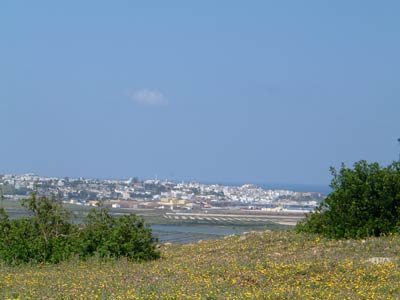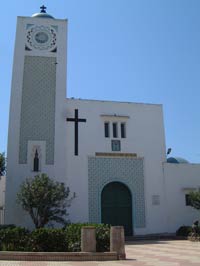|


      
|

Larache,
seen from the nearby Roman runis of Lixus
"Lharais
was built by the Africans [pre-Islam] on the coast, right where the
River Luccus meets the ocean. The town is bordered by the river on one
side and by the ocean on the other. In the days when both Arzilla [Asilah]
and Tangia [Tangier] belonged to the Moores, there were many people
in this town. But when both cities fell to the Christians, it was deserted
and remained empty, until recently. About 20 years ago,one of the sons
of the current Sultan of Fes decided to rebuild it. He fortified the
city and kept an army and full supplies in it at all times, as he was
suspicious of the Portugese. This town's port is hard to access, and
it is very difficult for ships to sail into the river. The son of the
Sultan also built a fort, which is constantly managed by a captain who
looks over 200 'arbalette-men', 100 archmen and 300 horsemen.
Around
Lharais there are a great many marches where one can fish and catch
birds. On the river banks there are forests, with many lions and other
ferocious beasts. The locals make coal which they ship to Arzilla and
Tangia. Mauritanians have a proverb which they use when something seems
illusory: "It is like a boat from Larache, with a cotton sail and
a cargo of coal". Coton is indeed to be
found in large quantities in the neighboring countryside. " (Leo,
251)
 Since
Leo's 1520 narrative, a great many things happened to the city of Larache.
Fortified by the Sultan of Fes and naturally protected by rough waters,
Larache served as a port for corsairs until it was taken by the Spanish
in 1610. It was temporarily regained by the Moroccans later in the century,
but destroyed in 1860 by Spanish bombarding. The Spanish settled there
in 1911, and the city became a center of Spanish culture in Morocco. The
city has kept much of its "spanish style"- with churches, iron
windows, hispanic looking market place. Since
Leo's 1520 narrative, a great many things happened to the city of Larache.
Fortified by the Sultan of Fes and naturally protected by rough waters,
Larache served as a port for corsairs until it was taken by the Spanish
in 1610. It was temporarily regained by the Moroccans later in the century,
but destroyed in 1860 by Spanish bombarding. The Spanish settled there
in 1911, and the city became a center of Spanish culture in Morocco. The
city has kept much of its "spanish style"- with churches, iron
windows, hispanic looking market place.
|